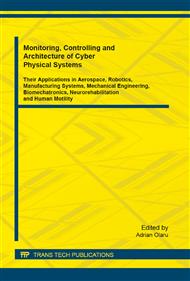[1]
B.S. Blanchard, Logistics Engineering and Management. Prentice-Hall, New York, (1998).
Google Scholar
[2]
D. Kececioglu, Maintainability, Availability and Operational Readiness Engineering Handbook. Volume1, DEStech, Lancaster, (2002).
Google Scholar
[3]
S. E Rigdon, A.P. Basu, Statistical Methods for the Reliability of Repairable Systems, John Wiley, New York, (2000).
Google Scholar
[4]
W.G. Schneeweiss, Reliability Modeling, LiLoLe – Verlag, Hagen, (2001).
Google Scholar
[5]
A. Villemeur, Reliability, Availability, Maintainability and Safety Assessment, John Wiley, New York, (1992).
Google Scholar
[6]
J. Furch, New Trends in a Vehicle Maintenance System, Advances in Military Technology 5 (2010) 111-119.
Google Scholar
[7]
J. Bartak, S. Cornak, R. Balik, Perspective Methods of Vehicles Maintenance, in: Proceedings of the Transport Means Conference, Kaunas university of technology, Kaunas, 2006, pp.183-186.
Google Scholar
[8]
IEC 60050-191 International Electrotechnical Vocabulary - Chapter 191: Dependability and Quality of Service, IEC, Geneva, (1990).
Google Scholar
[9]
IEC 601165 Application of Markov Techniques, IEC, Geneva, (2006).
Google Scholar
[10]
G.J. Kumar, V. Jain, O.P. Gandhi, Availability Analysis of Repairable Mechanical Systems Using Analytical Semi-Markov Approach, Quality Engineering 25 (2013) 97-107.
DOI: 10.1080/08982112.2012.751606
Google Scholar
[11]
Z. Vintr, R. Holub, R&M Requirements Allocation in Upgrading a System, in: Proceedings of Annual Reliability and Maintainability Symposium, IEEE, New York, (2001).
DOI: 10.1109/rams.2001.902477
Google Scholar
[12]
Z. Vintr, Weapon System Availability assessment, in: Proceedings of the International Conference on Military Technologies 2009 (ICMT'09), University of Defence, Brno, 2009, p.80 – 88.
Google Scholar
[13]
K.S. Trivedi, D.S. Kim, R. Ghosh, System availability assessment using stochastic models, in: Applied Stochastic Models in Business and Industry 29 (2013) 94-109.
DOI: 10.1002/asmb.951
Google Scholar
[14]
H. Garg, Reliability, Availability and Maintainability Analysis of Industrial Systems Using PSO and Fuzzy Methodology, in: MAPAN - Journal Of Metrology Society of India 29 (2014) 115-129.
DOI: 10.1007/s12647-013-0081-x
Google Scholar
[15]
Y.F. Li, R. Peng, Availability modeling and optimization of dynamic multi-state series-parallel systems with random reconfiguration, Reliability Engineering & System Safety 127 (2014) 47-57.
DOI: 10.1016/j.ress.2014.03.005
Google Scholar


